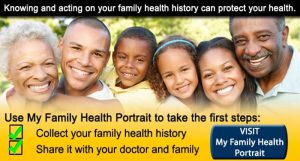Happy Thanksgiving 2021: Family Health History in the COVID-19 Era
Posted on by For a second year in a row, this Thanksgiving might not look the same as the ones before it, but some things haven’t changed. Even if you can’t see your loved ones in person, Thanksgiving is still a great time to talk to your family members about your family health history.
For a second year in a row, this Thanksgiving might not look the same as the ones before it, but some things haven’t changed. Even if you can’t see your loved ones in person, Thanksgiving is still a great time to talk to your family members about your family health history.
Having one or more family members with a disease can mean that you and others in the family are more likely to get that disease. But it’s not inevitable — for many chronic diseases, knowing about your family health history can empower you to take steps that make you less likely to get diseases that run in your family. In some cases, you and other family members can even change your family’s health history for future generations.
Want to get started? Use the My Family Health Portrait tool to collect your family health history information and share it with your family members and your doctor. Reaching out to older relatives this Thanksgiving? In many families, older relatives know more about the medical history of other relatives who are older and those who have passed away. If you’re talking to Grandma, take time to ask her to tell you about the family history of older family members (including her) and those who have died. If you are Grandma (or Grandpa), be sure to share this information with your younger relatives—they can learn a lot from you! My Family Health Portrait is easy to use and has had almost 3 million page views between 2019 and 2020. Check it out here.
Reinforcing the continued importance of family health history in public health and clinical care, the National Genome Research Institute at the National Institutes of Health launched web pages on family health history for individuals and families and health care providers. The Centers for Disease Control and Prevention (CDC) continues to promote the importance of family history through web pages on family health history and several different conditions, including hereditary breast and ovarian cancer, hereditary colorectal cancer, heart disease, and familial hypercholesterolemia. CDC hosts and continues to add features to My Family Health Portrait, which includes risk assessments for diabetes and colorectal cancer.
What are public health agencies such as CDC doing to increase the use of family history in clinical care and public health? One goal of the public health focus on family health history is to increase awareness and collection of family health history information, both by individuals and their health care providers. Recording of family health history information in electronic medical records still is not standardized, which limits the ability to use this information for public health purposes. For example, including family health history information in state cancer registries has been limited, as the information is not consistently recorded in medical records. This makes it challenging to find and use the information. Efforts to address this include the Centers for Medicare and Medicaid Services stage 2 meaningful use family history measure, which requires healthcare providers to record family history information for 20% or more of the patients seen during the reporting period. Despite these efforts, family health history collection in electronic medical records needs improvement so that this information can be more easily accessed and better used by health care providers and public health agencies. A November 18th CDC webinar discusses reinvigorating family health history in the era of genomics. In addition, as part of our online public health genomics and precision health knowledge base, we have developed a portal for the latest scientific publications and information relevant to family health history. Check it out here.
While public health efforts to encourage individuals and their health care providers to collect family health history information are important, encouraging individuals to take the next step – acting on this information – is essential to make sure that these efforts lead to improved health outcomes. Changing behavior is always challenging, and family history can both promote and prevent action. In some cases, people are motivated to take steps to prevent getting a disease that they have seen firsthand in other family members. For example, some individuals might be motivated to eat healthier and exercise more if they find out that they have prediabetes and are at increased risk of developing diabetes that runs in their families. Likewise, losing family members at a young age to cancer or heart disease can be what makes some individuals pursue earlier screening or genetic counseling. However, others might take a more negative view, assuming that they cannot avoid the disease that has affected other family members. How public health can combat this view and encourage action in the face of increased family history risk needs to be explored further. While some consider family health history to be a “simple” genomic tool, optimizing its use in clinical care and public health is anything but.
If you have any comments, questions, or concerns, please submit them below.
From our families to yours, we wish you all the best for Thanksgiving, also known as National Family History Day.
Posted on by


